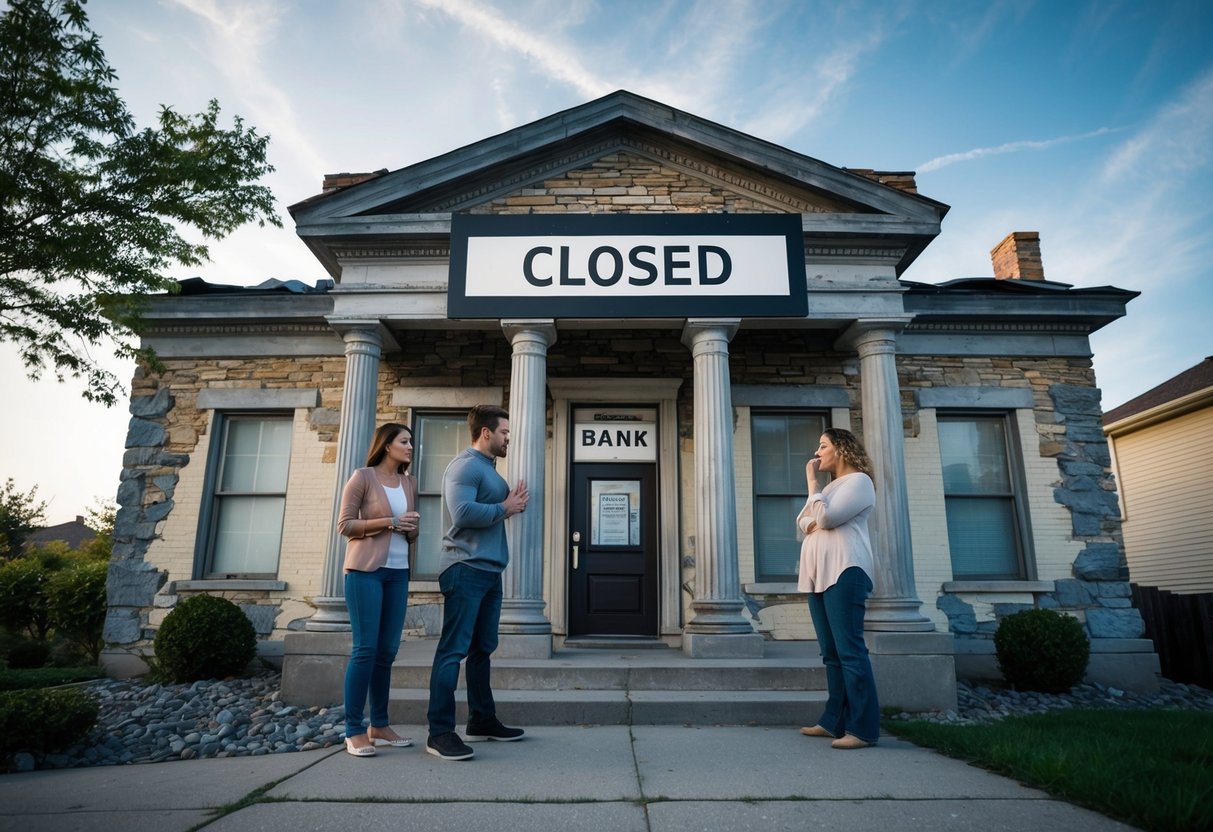Building societies in Australia are special financial groups that offer banking services. They’re owned by their members, not shareholders. This makes them different from regular banks.

Building societies in Australia provide savings accounts, home loans, and other financial products to their members. They work a lot like credit unions. Both are owned by the people who use their services.
Building societies have been around in Australia for a long time. Some started over 150 years ago. Today, there are fewer building societies than in the past. Many have changed into banks or joined with other financial groups.
Key Takeaways
- Building societies are member-owned financial groups that offer banking services
- They provide savings accounts, home loans, and other products to their members
- Building societies have a long history in Australia, but their numbers have decreased over time
History and Development of Building Societies

Building societies in Australia have a rich history dating back over 150 years. These member-owned financial institutions grew from humble beginnings to become important players in the Australian financial landscape.
Early Beginnings and Evolution
The first building society in Australia started in 1870. It was called B&E Ltd and still operates today. These early societies helped working-class people save money and buy homes. In the 1970s, building societies boomed. Many new ones opened across the country.
But the good times didn’t last. In 1974, a financial squeeze hit. Some building societies in South Australia and Queensland faced runs. People rushed to take out their money. More troubles came in 1976 and 1977 for Queensland societies.
Comparison to Banks and Credit Unions
Building societies are different from banks. You own part of the society when you join. Banks have shareholders instead. This setup is more like credit unions in the USA.
Building societies focus on savings accounts and home loans. Banks offer a wider range of services. Some building societies have changed over time. In 2011, Heritage Building Society became Heritage Bank Ltd.
Building societies still play a key role in Australia’s financial system. They give you another choice besides big banks. Their member-owned structure means they often offer better rates and lower fees.
Role and Definition
Building societies in Australia are member-owned financial institutions that offer banking and lending services. They operate differently from traditional banks and focus on serving their members’ needs.
Legal Structure
Building societies in Australia are structured as mutual organisations. This means you become a member when you open an account or take out a loan. As a member, you’re a part-owner of the society. Unlike banks, building societies don’t have external shareholders. They’re regulated by the Australian Prudential Regulation Authority (APRA) and must follow strict financial rules.
Building societies can offer many of the same products as banks. These include savings accounts, term deposits, home loans, and credit cards. Some building societies have converted to mutual banks in recent years. This lets them offer a wider range of services while keeping their member-owned structure.
Objectives and Values
The main goal of building societies is to benefit their members, not to maximise profits for shareholders. They aim to provide competitive financial products and personalised service. Many building societies focus on helping members save for and buy homes.
Building societies often stress community involvement and ethical practices. They may support local causes or offer special deals to members in financial hardship. Some building societies specialise in serving specific regions or professions.
You might find building societies offer better interest rates on savings or lower fees than big banks. However, they may have fewer branches or ATMs. Many building societies work together to give members access to a wider ATM network.
Products and Services
Building societies in Australia offer a range of financial products and services to meet their members’ needs. These include everyday banking accounts, home loans, and other financial offerings.
Savings and Transaction Accounts
Building societies provide several account options for your everyday banking and savings needs. You can open transaction accounts for daily use, with features like EFTPOS access and online banking.
Savings accounts are also available, often with higher interest rates than standard accounts. These help you grow your money over time.
Term deposits are another savings option. You can lock away a set amount of money for a fixed period, usually earning a higher interest rate than regular savings accounts.
Loan Products
Home loans are a key offering of many building societies. You can find options for first home buyers, investors, and those looking to refinance. These loans often come with competitive rates and flexible features.
Personal loans are also available for various purposes, such as buying a car or funding home renovations.
Some building societies offer credit cards, giving you a flexible way to manage your spending and earn rewards.
Additional Financial Offerings
Beyond basic banking, many building societies provide extra financial services. You might find insurance products, including home and contents cover, car insurance, and travel insurance.
Some offer financial planning services to help you manage your money and plan for the future. This can include advice on investments, superannuation, and retirement planning.
Digital banking tools are also common, with mobile apps and online platforms making it easy to manage your accounts, pay bills, and transfer money.
Interest Rates and Saving Options

Building societies in Australia offer competitive interest rates on savings accounts. You can find options with rates up to 5.75% per annum. These high-interest accounts help grow your money faster.
Many building societies provide online savings accounts. These often have better rates than traditional accounts. You can easily open and manage them through the internet.
Some key features of building society savings accounts include:
- Introductory bonus rates for new customers
- No monthly fees
- Easy online access to your funds
- Competitive ongoing interest rates
Here’s a quick look at some current top rates:
| Account Type | Interest Rate |
|---|---|
| Online Saver | Up to 5.75% p.a. |
| Term Deposit | Around 5.20% p.a. |
Keep in mind that the highest rates may only apply for a limited time. After the intro period, rates usually drop to a lower standard rate.
To get the best deal, compare different building societies. Look at both the introductory and ongoing rates. Also check if there are any conditions to earn the top rate.
Building societies might offer term deposits too. These lock your money away for a set time. In return, you get a fixed interest rate. This can be good if you want to save for a specific goal.
Home Loans and Mortgages

Building societies in Australia offer home loans and mortgages to help you buy property. These loans let you borrow money to purchase a home while paying it back over time with interest.
Features and Benefits
Building society home loans often have competitive rates. You may find lower fees compared to big banks. Many offer flexible repayment options. You can usually make extra payments without penalties. Some let you redraw extra payments if needed.
Building societies focus on customer service. You might get more personal attention than at a large bank. They may be more willing to work with you if you have an unusual situation. Some offer special deals for first-home buyers.
Fixed and variable rate options are available. Fixed rates give you certainty about repayments. Variable rates can go up or down with the market. Some loans offer features like offset accounts to reduce interest.
Application and Approval Process
To apply, you’ll need to show proof of income and savings. Building societies look at your credit history and current debts. They assess if you can afford the loan repayments.
You’ll need to provide ID and financial documents. This includes bank statements, payslips, and tax returns. The society will value the property you want to buy.
The approval process can take a few days to a few weeks. Once approved, you’ll get a loan offer. Read it carefully before signing. You’ll then settle the purchase and start making repayments.
Some building societies offer pre-approval. This gives you an idea of how much you can borrow before you start house hunting.
Banking Services
Building societies in Australia offer a wide range of banking services to meet your financial needs. These services are designed to be accessible and convenient for members.
Branch and Digital Banking
You can access your building society accounts through multiple channels. Many building societies have physical branch locations where you can do your banking in person. Staff are on hand to help with transactions and answer questions.
For everyday banking, you can use online banking platforms. These let you check your balance, transfer money, and pay bills from your computer. Mobile banking apps give you the same functions on your smartphone or tablet. You can bank on the go, anytime.
ATMs are available for cash withdrawals and deposits. Some building societies have their own ATM networks. Others partner with banks to give you access to a wider range of machines.
Customer Services and Support
Building societies pride themselves on personal service. You can get help by phone, email, or online chat. Many have extended customer service hours to fit your schedule.
If you need financial advice, building societies often offer free consultations. They can help with budgeting, savings goals, and loan applications. Some provide financial education programs to boost your money skills.
For complex issues, you might speak to a specialist. This could be for home loans, business banking, or investment advice. Building societies aim to give you tailored support for your unique needs.
Financial Performance and Security
Building societies in Australia have a strong financial record. They offer secure options for savers and borrowers alike. Let’s look at their assets and how they’re regulated.
Assets and Profitability
Building societies manage large sums of money. Their assets often reach billions of dollars. For example, B&E Ltd has over $1.2 billion in total assets. This shows the scale of these institutions.
Building societies aim to make profits for their members. Unlike banks, they don’t have shareholders to please. This can lead to better interest rates for you.
They make money through loans and investments. Mortgages are a big part of their business. They also offer savings accounts and other financial products.
Regulations and Supervision
The Australian Prudential Regulation Authority (APRA) keeps a close eye on building societies. They must follow strict rules to protect your money.
Building societies are covered by the Financial Claims Scheme (FCS). This protects your deposits up to $250,000 per account holder. It’s the same protection you get with banks.
APRA makes sure building societies have enough money to cover their promises. They check their financial health regularly. This helps keep your savings safe.
Building societies must report their finances to APRA. This transparency helps you make informed choices about where to put your money.
Membership and Ownership
Building societies in Australia are owned by their members. When you join a building society, you become a member-owner. This means you have a say in how the society runs.
Unlike big banks, building societies don’t have shareholders. They’re run for the benefit of their members. Any profits go back to improving services or lowering fees.
Members get voting rights. You can vote on important decisions at annual meetings. You might even be able to run for the board of directors.
Some building societies have changed to mutual banks or customer-owned banks. These still keep the same member-owned structure. They just have different names.
The value of being a member comes from better service and lower fees. You won’t get shares or dividends like with a public company. Instead, you get banking that puts you first.
To join, you usually need to open an account or take out a loan. Some societies might ask you to buy a small membership share. This is different from owning shares in a normal bank.
Charges and Fees
Building societies in Australia often have lower fees than big banks. You might pay less for everyday banking with a building society.
Common fees include:
- Account keeping fees
- ATM withdrawal fees
- Overdraft fees
- Late payment fees
Some building societies offer fee-free accounts. Check the terms and conditions carefully before opening an account.
Transaction accounts may have different fee structures. Some charge per transaction, while others offer a set number of free transactions each month.
To avoid fees:
- Keep your account balance above the minimum
- Use your building society’s ATMs
- Set up direct debits for bills
- Use online banking when possible
Your account number is important for transactions. Make sure you provide the correct details to avoid extra charges.
Building societies aim to keep costs down for members. They often reinvest profits into better rates and services. This can mean lower fees for you compared to traditional banks.
Always ask about all possible charges when opening an account. This helps you budget and avoid surprise fees later on.
Mergers and Terminations

Building societies in Australia have faced major changes in recent decades. Many have merged with banks or other societies, while others have shut down completely.
Nationwide Trends and Cases
In the 1980s, Australia had over 100 building societies. Now there are only a handful left. Most merged with banks or converted to banks themselves. The Bendigo Bank merged with First Australian Building Society in 2000. This joined a Victorian bank with a Queensland building society. It kept all 47 First Australian branches open.
Other societies closed down. The ABS Building Society was bought by Greater Building Society in 2011. Greater later became Greater Bank. B&E Ltd in Tasmania is one of the few building societies still running. It has over 30,000 clients and $1.2 billion in assets.
The Future of Building Societies
Building societies face tough competition from banks. Many have trouble staying afloat as separate entities. Some experts think the remaining societies may not last much longer. They might need to merge or become banks to survive.
But building societies still have some advantages. They often focus more on customer service than big banks. Some people prefer their community-focused approach. Building societies might find ways to use these strengths to stay relevant in the future.
Notable Building Societies in Australia
Building societies play a big role in Australia’s banking sector. They offer many financial services to their members. Let’s look at some of the most well-known ones.
Greater Bank
Greater Bank started as a small building society in NSW. It’s grown a lot since then. In 2011, it bought ABS Building Society. This made it even bigger.
Greater Bank serves over 270,000 customers. It has branches in NSW and southeast Queensland. The bank offers home loans, savings accounts, and credit cards.
Greater Bank is known for its community focus. It gives money to local groups and events. This helps it stay close to its members.
NSW-Based Societies
NSW has several building societies. Newcastle Permanent is a big one. It’s been around since 1903. The society has over $11 billion in assets.
Illawarra Credit Union serves people in the Illawarra region. It started in 1972. The credit union offers home loans and savings accounts.
Penrith Mutual is smaller but still important. It focuses on the Penrith area. The society gives personalised service to its members.
Other Prominent Examples
Heritage Bank is Queensland’s largest customer-owned bank. It changed from a building society to a bank in 2011. Heritage Bank has over $10 billion in assets.
Australian Military Bank serves Defence Force members. It offers special deals for military personnel. The bank has branches on many bases.
Qudos Bank used to be Qantas Credit Union. It’s open to everyone now, not just Qantas staff. The bank has over 100,000 members across Australia.
The Mutual is based in Maitland, NSW. It’s been around since 1888. The society focuses on personal service and community support.
Frequently Asked Questions

Building societies play a unique role in Australia’s financial landscape. These member-owned institutions offer various services and have some key differences from other financial providers.
How do building societies differ from banks in Australia?
Building societies are owned by their members, not shareholders. They often focus on savings accounts and home loans. Banks have a broader range of services and are typically profit-driven.
Building societies may offer more personalised service. They tend to have a stronger local presence in specific regions or communities.
Can you provide examples of building societies operating in Australia?
B&E Ltd is Australia’s oldest building society, founded in 1870. It serves Tasmania with over 30,000 clients.
ABS Building Society operated until 2011. It was then bought by Greater Building Society, which is now Greater Bank.
What are the advantages of using a building society over other financial institutions?
Building societies often have lower fees and better interest rates. They may offer more personalised service due to their smaller size.
Members can have a say in how the society is run. Profits are usually reinvested to benefit members rather than paid to shareholders.
Are building societies in Australia subject to the same safety regulations as banks?
Yes, building societies face the same strict regulations as banks. The Australian Prudential Regulation Authority (APRA) oversees them.
APRA ensures building societies maintain financial stability. Your money is just as safe in a building society as in a bank.
How do the services of Australian building societies compare with credit unions?
Building societies and credit unions are both member-owned. They offer similar services like savings accounts and home loans.
Credit unions might have a broader range of products. Building societies often specialise in savings and mortgages.
Do building societies in Australia still exist and what services do they provide?
Yes, building societies still operate in Australia. They offer savings accounts, term deposits, and home loans.
Some building societies provide personal loans and insurance. Online banking and mobile apps are now common features too.





